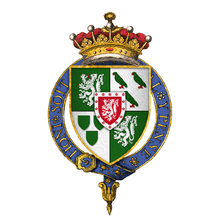George Home, 1st Earl of Dunbar


George Home, 1st Earl of Dunbar, KG, PC (ca. 1556 – 20 January 1611) was, in the last decade of his life, the most prominent and most influential Scotsman in England. His work lay in the King's Household and in the control of the State Affairs of Scotland and he was the King's chief Scottish advisor. With the full backing and trust of King James he travelled regularly from London to Edinburgh via Berwick-upon-Tweed.
In Scotland
Home was the son and third child of Sir Alexander Home of Manderston, Berwickshire, and was introduced, at the age of 26, to the Court of sixteen-year-old James VI by a relative, Alexander Home, 6th Lord Home. Establishing himself as a favourite at court, he was in the retinue which accompanied King James VI to Norway and Denmark to collect his future Queen. He was knighted on 4 November 1590, appointed a Privy Counsellor in 1598, and the following year appears as Sheriff of Berwick-upon-Tweed, (by then in England). In 1601 he was made Master of the King's Wardrobe, and on 31 July the same year was appointed one of the Componitors to the Lord High Treasurer, and acceded to that position in September. In 1601 he was also made Provost of Dunbar.
In England
Upon James's accession as James I of England in 1603, Home accompanied his sovereign to Westminster, where he became Chancellor of the Exchequer (and ex officio the Second Lord of the Treasury) from 1603 to 1606. In 1603 he was also appointed to the Privy Council of England, and on 1 June that year received a grant as Keeper of the Great Wardrobe for life. On 7 July 1604 he was created Baron Hume of Berwick in the Peerage of England. In 1605 he was appointed a Knight of the Garter, and on 3 July was created Earl of Dunbar in the Peerage of Scotland. There is evidence that he took a part in the interrogation of Guy Fawkes in the immediate aftermath of the Gunpowder Plot of 1605.
Landed interests
Of these, on the 27 September 1603 Home received the manor and castle of Norham, with its fishing rights on the River Tweed. On 12 December a Royal Charter gave him the custody and captaincy of the Castle of St Andrews. In July 1605 he had a confirmation of all the lands previously granted to him incorporated and combined into a free earldom, Lordship of Parliament, and Barony of Dunbar.
Religious affairs
In 1608, Home journeyed to Scotland with George Abbot to arrange to promote the Episcopal Church, and to seek some sort of union between the Church of England and Church of Scotland. King James was pleased with the initial results, although the hoped-for Union never occurred and the gulf between the King and the General Assembly of the Church of Scotland widened. In July 1605 some nineteen ministers assembled at Aberdeen in defiance of the King's prohibition against the General Assembly meeting. Six of them were subsequently imprisoned in Blackness Castle near Linlithgow, and there, on 10 January 1606, the Earl of Dunbar came from London to be present at their trial and to act as the assessor. Everything was done that could be done by him to win a verdict for the King against the six ministers and it is said that he "brought plenty of money with him to purchase a verdict". In addition, the Earl himself selected the 15 jurymen, five of whom were Homes, his relatives. But even then the jury could not agree. In the end it was a majority verdict of nine against six in favour of the guilty verdict. Regardless of the irregularities, the verdict stood, and established the law that it was High Treason for any minister of the Established Church to dispute the authority of the King and the Privy Council in religious matters.
Death
The Earl of Dunbar died in Whitehall, London, in 1611, without male issue, whereupon the earldom and the barony became Dormant. By his wife Catherine, daughter of Sir Alexander Gordon of Gight, he left two daughters:
- Anne (d. 1621), who married Sir James Home of Whitrig (d. between 1614–1620), (whose son became James Home, 3rd Earl of Home).
- Elizabeth, who married Theophilus Howard, 2nd Earl of Suffolk.
His body was embalmed, but his funeral service did not take place in Westminster until April, after which his body was placed in a lead coffin and sent to Scotland where it was buried under the floor of Dunbar parish church, midway between the font and the pulpit. A magnificent monument, said to be finer than any in Westminster Abbey, was erected in his honour, which is still the distinguishing feature of the interior of this church.
See also
References
- George Home, Earl of Dunbar, three lectures by the Reverend J Kirk, MC, CF, (Minister of Dunbar Parish Church 1913-1918), Edinburgh, 1918.
- MSS of Colonel Mordaunt-Hay of Duns Castle, Historical Manuscripts Commission, collection no.5, 1909, page 66, number 180. His lordship is cited as deceased, and although the daughters are mentioned, there is nothing to indicate either of them assuming the peerage.
| Political offices | ||
|---|---|---|
| Preceded by John Fortescue |
Chancellor of the Exchequer 1603–1606 |
Succeeded by Sir Julius Caesar |
| Vacant Title last held by The 3rd Earl of Cumberland |
Lord Lieutenant of Cumberland, Northumberland, and Westmorland jointly with The 4th Earl of Cumberland The Earl of Suffolk Lord de Clifford 1607–1611 |
Succeeded by The 4th Earl of Cumberland The Earl of Suffolk Lord de Clifford |
| Peerage of Scotland | ||
| New title | Earl of Dunbar 1605–1612 |
Extinct |
| Lord Hume of Berwick 1604–1612 | ||
.svg.png)